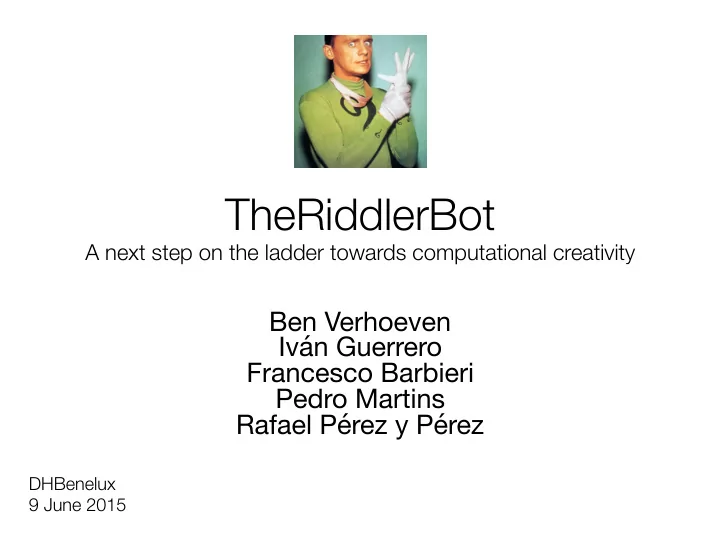

TheRiddlerBot � A next step on the ladder towards computational creativity Ben Verhoeven Iván Guerrero Francesco Barbieri Pedro Martins Rafael Pérez y Pérez DHBenelux 9 June 2015
Different Twitter users • People
Different Twitter users • Organizations
Different Twitter users • Bots
We present TheRiddlerBot � • Interactive Twitter bot • Creates riddles • Strives to be � considered creative
Riddles • Text fragments that employ ordinary language restricted by semiotic, aesthetic and grammatical constraints � (Pepicello & Green, 1984) • Language game, initiated by a question, with the goal to mislead the guesser � (Weiner & De Palma, 1993) • What has no beginning, end or middle?
Creativity • To be creative usually relates to the generation of something novel and interesting, not only to oneself, but also to partners sharing a common background (Mayer 1999)
Twitter bots • Automatic Twitter users Different types of bots (Cook 2015) • feeder bots, which create tons of Tweets for their followers (mere generation); • watcher bots: constantly looking for specific texts to extract information; • interactive bots: which ask followers for specific ways of communication and information sharing
Feeder bots
Feeder bots
Watcher bots
Watcher bots
Interactive bots
More on bots? • A brief history of the future on Twitter bots Michael Cook (2015) - @mtrc • http://www.gamesbyangelina.org/talks/ codecamp.pdf • Also check: #botally on Twitter
Computational Creativity • First generation Twitter bots: Tweet- generating systems that autonomously perform useful and well-defined services (Veale 2014) • Second generation bots: supposed to be creative on purpose instead of hit-and-miss. High curation coefficient: evaluate outputs before posting. (Veale 2015)
Our system: TheRiddlerBot Specific task: • Create a riddle about a famous person/ character • Use both structured and poorly-structured real-world resources • Evaluate its own output where possible • Interact with Twitter users
Our model • Five modules that each have the same three layers in it
Character selection • Non-Official Character (NOC) list (Veale, 2015) > 800 characters > 20 attributes, e.g. gender, profession, adjectives, … • Select one, possibly taking public relevance into account (~Google News) • Expand from Wikipedia: persons that have a page in at least 50 languages
Feature extraction Information Retrieval • Gathers attributes from NOC list • Combine with information (hypernyms) from common sense knowledge bases, e.g. Perception in NodeBox, ConceptNet • Also poorly-structured sources, e.g. Wikipedia Processing • Select three attributes Evaluation • Evaluate attributes on uniqueness and interestingness – Subset of features is unique when refers to 1 person
Perception (NodeBox) www.nodebox.net/perception ¡
Analogy generation • Comparisons with different characters – Fictional world • E.g. Doc Emmett Brown is like Walter White but in Back to the Future – Group affiliation • E.g. Lisa Simpson is the Timothy McGee of The Simpsons Family
Natural language generation • Retrieval of different types of phrasal templates for parts of the riddle – Initial phrase – Clues – Final question • Phrasal template: previously-known sentence with slots to be further filled by specific words • Different templates exist for each type to have a wider variety of generations.
Example phrasal templates
User interaction • Twitter users can guess the answer to the riddle • The bot will check if the answer is correct with the official name and all Wikipedia aliases • The bot replies: correct or false, also with different templates.
Sample riddles generated • Who is a basketball player, fast yet smug, lives in USA, wears clown shoes? • Who is a sultry actress, loves starring in Hollywood movies, likes wearing a tight dress? • Who can be found in Germany, wears an SS uniform, is the Colonel Kurtz of The Nazi Party?
Evaluation • Metadata of the bot (number of retweets, favorites, answers, …) could be used for evaluation? • Some statistics: – 57 followers – 285 riddles generated – 10 different users with 34 correct answers
Evaluation • Crowd-sourced quality-control • 86 people evaluated 5 riddles each
Evaluation • Crowd-sourced quality-control • 86 people evaluated 5 riddles each
Best riddles generated • Who is a creative professional, pretty yet superficial, can be found in USA, enjoys monetizing celebrity status? • Who is a religious leader, loves spreading Christianity, likes wearing sandals? • Who is a creator, can be found in Italy, wears a paint-stained smock?
To conclude • We built an interactive Twitter bot that generates riddles and posts responses to guesses. • The novelty and creativity is in – The combination of well-structured and poorly- structured information sources. – The creation of analogies • The fun is in the gamification. • Entire code available online: � https://github.com/ivangro/theriddlerbot
Let’s ¡play! ¡
Recommend
More recommend